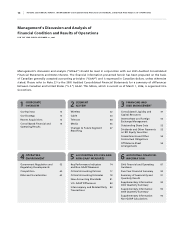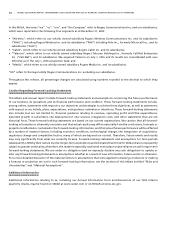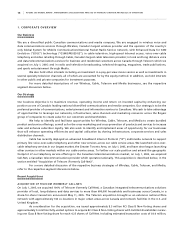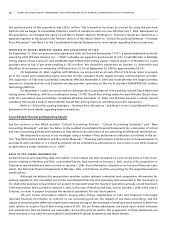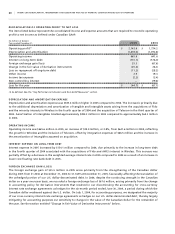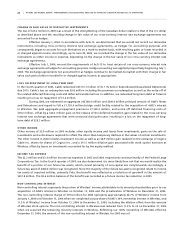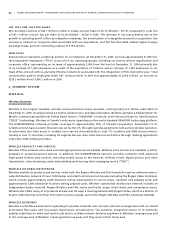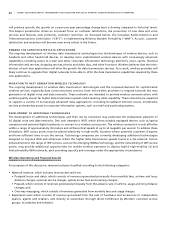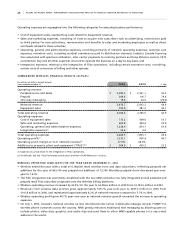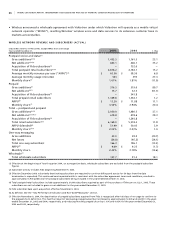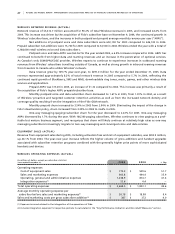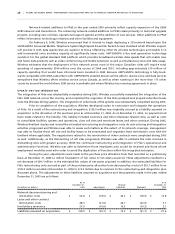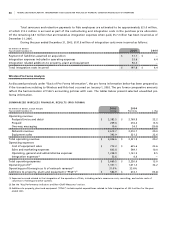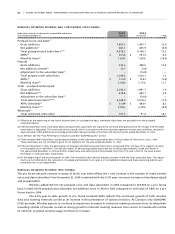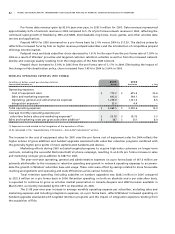Rogers 2005 Annual Report Download - page 27
Download and view the complete annual report
Please find page 27 of the 2005 Rogers annual report below. You can navigate through the pages in the report by either clicking on the pages listed below, or by using the keyword search tool below to find specific information within the annual report.
23 ROGERS 2005 ANNUAL REPORT . MANAGEMENT’S DISCUSSION AND ANALYSIS OF FINANCIAL CONDITION AND RESULTS OF OPERATIONS
Wireless operates a digital wireless GSM/GPRS network in the 1900 megahertz (MHz) and 850 MHz frequency
bands across its national footprint. The GSM/GPRS network, which was initially deployed in 2002, operates seamlessly
between the two frequencies and provides high-speed integrated voice and packet data transmission service capabilities.
During 2004, Wireless completed the deployment of EDGE technology across its national GSM/GPRS network.
Accomplished by the installation of network software upgrades, EDGE more than tripled the wireless data transmission
speeds previously available on the network. In December 2005, Wireless initiated testing of UMTS/HSDPA third
generation (“3G”) wireless technology in the downtown core of Toronto. UMTS/HSDPA is the next phase of the evolution
of the GSM/EDGE platform delivering high mobility, high bandwidth wireless access for voice and data services, as
discussed in the “Additions to PP&E” section.
Fido’s wireless network was also a GSM/GPRS network operating on the 1900 MHz frequency band. During 2005,
Wireless completed the process of integrating the Rogers Wireless and Fido GSM/GPRS networks. This network integra-
tion enabled Wireless to increase the density and quality of its wireless coverage while also reducing costs through the
elimination of redundant cell sites and other network facilities.
Including the acquired Fido spectrum, Wireless holds 25 MHz of contiguous spectrum across Canada in the
850 frequency range and 60 MHz in the 1900 frequency range across the country with the exception of Southwestern
Ontario, Northern Québec, and the Yukon, Northwest and Nunavut territories where Wireless holds 50 MHz in the
1900 frequency range.
Wireless also holds certain broadband fixed wireless spectrum in the 2300 MHz, 2500 MHz and 3500 MHz fre-
quency ranges. In September 2005, Wireless, together with Bell Canada announced the formation of an equally owned
joint venture to construct a pan-Canadian wireless broadband network that will be based on the evolving Wi-MAX
standards. Both companies will contribute their respective fixed wireless spectrum holdings to the joint venture, along
with access to their respective cellular towers and network backhaul facilities. The fixed wireless network will act as a
wholesale provider of capacity to each of the joint venture partners who in turn will market, sell, support and bill for
their respective service offerings over the network.
Wireless Strategy
Wireless’ goal is to achieve profitable growth within the Canadian wireless communications industry, and its strategy is
designed to maximize its cash flow and return on invested capital. The key elements of its strategy are as follows:
• Enhancing its scale and competitive position in the Canadian wireless communications market through the acquisition
and integration of Fido;
• Focusing on voice and data services that are attractive to youth, families, and small and medium-sized businesses to
optimize its customer mix;
• Delivering on customer expectations by improving handset reliability, network quality and customer service while
reducing subscriber deactivations, or churn;
• Increasing revenue from existing customers by utilizing analytical tools to target customers likely to purchase optional
services such as voicemail, caller line ID, text messaging and wireless Internet;
• Enhancing sales distribution channels to increase focus on youth and business customers;
• Maintaining a technologically advanced, high-quality and pervasive network by improving the quality of the GSM/
GPRS/EDGE network and increasing capacity; and
• Leveraging relationships across the Rogers group of companies to provide bundled product and service offerings
at attractive prices, in addition to implementing cross-selling and joint sales distribution initiatives as well as cost
reduction initiatives through infrastructure sharing.
Recent Wireless Industry Trends
FO C U S O N C US T O ME R R E TE N T IO N
The wireless communications industry’s current market penetration in Canada is approximately 52% of the population,
compared to approximately 69% in the U.S. and approximately 114% in the United Kingdom, and Wireless expects the
Canadian wireless industry to grow by approximately 4 to 5 percentage points of penetration each year. While this


